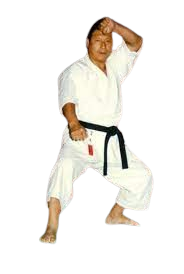HOJO UNDO - gli esercizi supplementari
Hojo Undo 補助運動
Maestro Chojun Miyagi: "Il karate è la capacità di addestrare il proprio corpo al punto di poter sconfiggere un avversario anche armato, con una tecnica a mani nude". 
Il karate sportivo (o agonistico) si esplica essenzialmente in due "specialità": il kata, concetrato unicamente sulla forma, ed il kumite ovvero il combattimento che a seconda della "radice culturale di provenienza" risponde a regole che lo possono far tendere verso un aspetto prettamente sportivo ed atletico (shobu sanbon ippon), piuttosto che verso un'impostazione un pò più marziale (shobu ippon) in quanto in quest'ultimo caso viene premiata una tecnica potenzialmente risolutrice piuttosto che un "bilancio finale del combattimento" tipo i punti della boxe.
Il karate tradizionale o classico è essenzialmente uno dei sistemi di difesa personale più sofisticati che sia stato concepito dall'uomo (...scrivo anche "o classico" per i puristi..) e prevede invece un allenamento quotidiano anche attraverso i cosiddetti "esercizi supplementari" (la traduzione di hojo undo) in cui risiedono i veri segreti ed attraverso cui si riescono ad ottenere condizionamenti psicofisici difficilmente immaginabili. Ancora un ulteriore distinzione andrebbe fatta fra Karate-do, Karate-Jutsu, Goshin-do e Goshin-Jutsu... ma il web non è il luogo adatto...
Alcuni attrezzi quali makiwara, chiishi, nigiri gami, kongoken, kigu ecc, uniti al kobudo, consentono di completare quella parte di allenamento specifico.... che di norma risiede nel lato in ombra della luna...
Antonio Corrias
Presso l' Hombu Dojo Arezzo, tra le pochissime in Italia, nel totale rispetto della tradizione, è possibile, anche per istruttori e maestri di altre scuole, approcciare questa antica metodica di allenamento partecipando ai periodici stages dedicati ed a numero chiuso.
Per eventuali contatti è disponibile l'apposito modulo presente alla voce "ISCRIVITI ONLINE"
(In foto alcuni attrezzi utilizzati presso l'Hombu-dojo di Arezzo) 
Hojo undo(Supplementary training)
Hojo undo, or supplementary training, is the term used in Karate to refer to training withequipment (also known as kigu undo). Since ancient times, Okinawan karateka have been using domestic tools to build up strength, develop impact power, and therefore enhance their martial practice. Using the tools is the key to developing the devastating power of Karatetechniques. Miyagi Chojun Sensei stressed that the practice of kata without the correct physical conditioning of the body amounted to nothing more than gymnastics and could not be considered true bujutsu (martial art). By forging the techniques found in the kata, the value of hojo undo training becomes apparent.
Supplementary exercises, hojo undo, are practiced with the aim of perfecting the kata. The purpose of these exercises is not only to develop strength and power in the body as a whole, but to develop each part of the body individually in order to develop complete body power.
Miyagi Chojun

The various training equipment used at the Karate Kenkyukai Dojo.

Miyagi Chojun overseeing hojo undo training at the Kenkyukai Dojo.
(c.1928)

Miyagi Chojun surrounded by young students and hojo undo equipment.
(c.1942)
Lifting tools
The benefits of hojo undo training are well documented, and contrary to what many believe, we don't think that modern weight training comes even close to providing a way of exercising that is so specific to Karate technique. The important thing to remember here is that hojo undo is not intended to build large muscles. For this purpose modern training methods are undoubtedly much more effective. The purpose of hojo undo is to help the practitioner realise a 'feeling' for specific technique. The muscle building and conditioning element of hojo undo is a welcome side effect of the training.
Training for any physical activity always requires supplementary equipment. In Karate there are some tools that are essential and have not changed since the founding days of this art but, these days, there are those who reject them, considering them outdated. In my opinion they remain critical.
Motobu Choki




